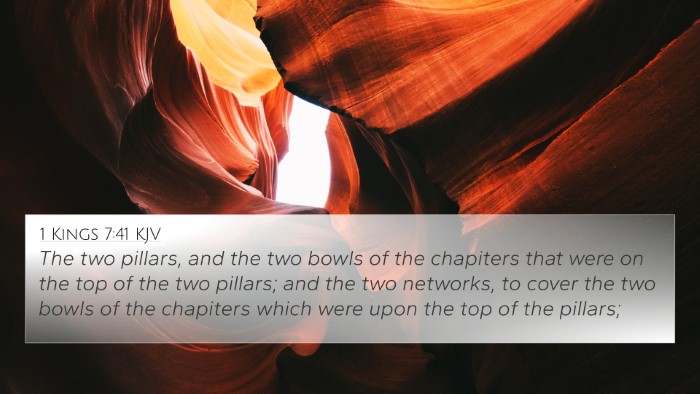Understanding 2 Chronicles 4:12
2 Chronicles 4:12 speaks about the construction of the temple, specifically detailing the bronze work done for its various components. This verse highlights the artistry and skill involved in the sacred work of building God’s house. Below, we explore the meaning of this verse by integrating insights from renowned public domain commentaries such as those by Matthew Henry, Albert Barnes, and Adam Clarke.
Verse Context & Summary
This verse is a part of the broader narrative concerning the construction of Solomon's temple, a significant event in Biblical history. It showcases the materials used and the craftsmen involved, emphasizing the importance of both the physical aspects and the spiritual significance of this sacred place.
Commentary Insights
- Matthew Henry:
Henry notes that the work of the temple was undertaken with great care and precision. He emphasizes that the temple was intended to be a reflection of the glory of God, built with the finest materials, demonstrating not only Solomon’s wealth but also his devotion. The bronze in this context signifies strength and durability, characteristics befitting a place dedicated to the Almighty.
- Albert Barnes:
Barnes highlights the significance of the brass work mentioned in the verse, connecting it to the overall grandeur and sophistication of the temple structure. He suggests that this physical beauty was designed to encourage reverence among worshippers, as the temple was where God chose to dwell among His people.
- Adam Clarke:
Clarke provides insight into the artisanship involved in creating the bronze pieces of the temple. He elaborates on the skill required for such work, indicating that the craftsmen were not only talented but inspired to honor God through their work. Clarke underscores the idea that every piece crafted held significance in the worship of God.
Related Bible Cross-References
This verse can be connected to several other scriptures that enhance its meaning and significance:
- 1 Kings 6:7: Discusses the construction methods used in the temple, emphasizing the importance of silence during the building process, which reflects the sacredness of the task.
- Exodus 25:8-9: Highlights God's command to build a sanctuary for Him, indicating the importance of having a dedicated space for worship.
- Isaiah 66:1-2: Speaks about God’s dwelling place and His rejection of superficial worship, pointing to the true heart of worship beyond mere physical structures.
- 2 Chronicles 3:1: Provides context on the location chosen by Solomon for constructing the temple, signifying God's purposeful design in selecting a sacred space.
- Hebrews 9:24: Relates the earthly temple to the heavenly realities, connecting the physical worship through the temple with spiritual truths in Christ.
- 1 Chronicles 28:11-12: Shows David’s preparations for temple construction, emphasizing the lineage and the plans for the temple’s architecture.
- Psalm 27:4: Expresses the longing for dwelling in the house of the Lord, linking personal devotion to communal worship within the temple.
Thematic Connections
In interpreting 2 Chronicles 4:12, one can see themes of craftsmanship, devotion, and the sacredness of God’s presence emphasized throughout the Bible:
- Craftsmanship and Dedication: The artisanship required in temple construction mirrors the dedication required of believers in their service to God.
- God’s Presence: The physical temple represents God’s desire to dwell among His people, a theme continued into the New Testament through Christ.
- Worship and Reverence: The physical beauty of the temple serves to inspire awe and reverence in worshippers, echoing the call for holiness in worship.
Conclusion
2 Chronicles 4:12 invites believers to reflect on the significance of sacred spaces and the importance of craftsmanship dedicated to God’s glory. By studying related verses and themes, we can gain a deeper understanding of how the physical aspects of the temple foreshadow the spiritual realities experienced in Christ. Cross-referencing these scriptures enriches our study and allows for a more comprehensive understanding of Biblical truths.
Tools for Bible Cross-Referencing
For those interested in exploring cross-references more thoroughly, consider utilizing tools such as:
- Bible Concordance: An alphabetical listing of words and topics covered in the Bible, helping users locate verses quickly.
- Bible Cross-Reference Guide: Offers structured cross-references to help identify connections between various scriptures.
- Cross-Reference Bible Study: Engages believers in deeper study through related texts, enhancing understanding.
- Bible Chain References: A method that ties related verses together, creating a pathway through scripture.




